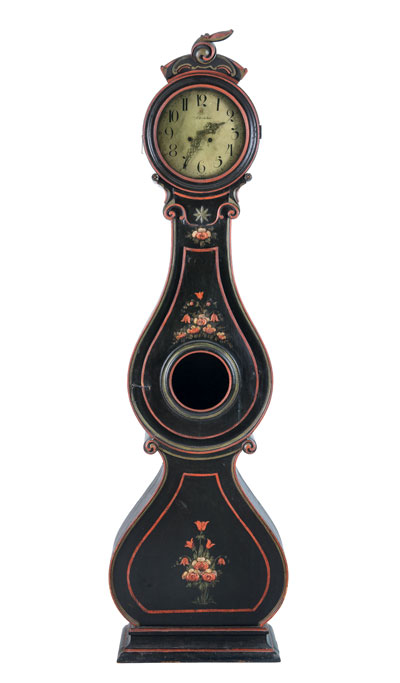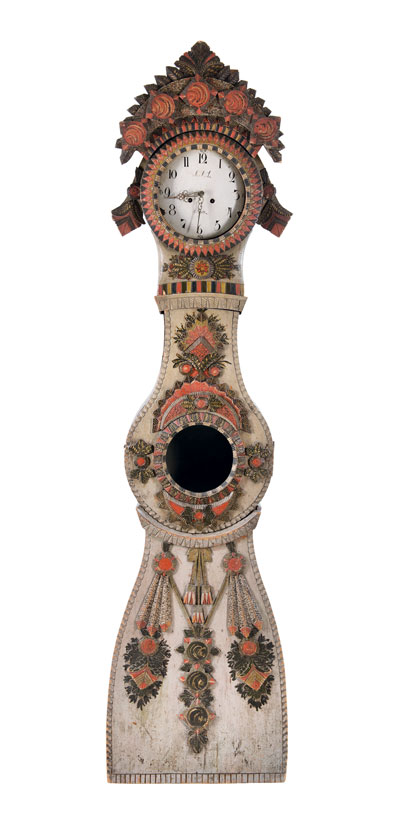Long, Tall and Swedish
Writer Leslie Gilbert ElmanDistinctive Swedish case clocks are highly sought-after.
The final episodes of the Masterpiece Mystery series Wallander aired recently on PBS. Based on the crime novels by Swedish writer Henning Mankell, the series was filmed mainly in Sweden, and it’s beautiful to look at.
Occasionally it ventures into elegant surroundings, such as the historic estate of a character named Håkan von Enke. That’s where I noticed the clock. Its shapely rococo form might have originated in France, but decoratively this clock was unmistakably Swedish. Known generally as golvur—the Swedish word for grandfather clocks—but more often as Mora clocks, these curvy, tall-case clocks were characteristic of late-18th century to mid-19th century Swedish decor.
Around the 1870s they went out of fashion, as interior furnishing styles will do. In recent years, however, they’ve resurfaced, much to the delight of buyers and sellers of classic Swedish furniture.
How Are Things in Mora?
Mora clocks trace their origin to the city of Mora in the Swedish province of Dalarna. Or, more precisely, to the village of Östnor near Mora and a man called Krång Anders Andersson who was born there in 1727.
Dalarna is a vast and sparsely populated region, covering nearly 11,000 square miles with a population density of about 25 people per square mile. (To put it in perspective, New Jersey is about two-thirds Dalarna’s size and packs in 1,218 people per square mile.) Dalarna is quiet, it’s beautiful and it has a long history of folk art craftsmanship, most famously the red-painted wooden Dala (or Dalecarlian) horses that rural folks would carve and paint during the long northern winter.
In 1700, in the tiny Dalarna village of Stjärnsund, the famous Swedish mechanical engineer Christopher Polhem founded a factory that made clocks. Reputedly it was in Polhem’s factory that Krång Anders Andersson learned clock-making. Sometime around 1740-1750, Andersson established his own clock-making business in Östnor.
Andersson’s scheme exemplified the best of community involvement and division of labor, with each craftsman responsible for one aspect of the finished piece—forging the hands, painting the clock face, and so on. Clock-making gave a welcome boost to the struggling local economy and it gave Mora a strong, new identity. As a Swedish writer said in a 1834 travelogue, “The whole town is one clockmaker.”
Clocks made by Krång Anders Andersson’s company have “A.A.S. Mora” written on their faces. The A.A.S. stands for Anders Anders Son. “It was a brand that represented a certain quality,” says Ulla-Karin Warburg, a curator at the Nordiska museet in Stockholm. In most cases, the clockworks were manufactured in Mora and then sold in other parts of Sweden where local craftsmen would make and decorate the clock cases.
Here Come the Brides
Clock cases were crafted individually, sometimes whimsically. That’s especially true for the clocks affectionately known as “Ångermanland Brides.” They resemble a bride on her wedding day, from the ribbons and tassels on her dress to the flower crown atop her head. The style probably originated in Sweden’s Medelpad province and became a particular favorite of the prosperous farmers in neighboring Ångermanland province.
Whether a clock case had a plump “belly,” a long “neck” or a tapered figure depended on regional and personal preferences. Each clock case was composed of hundreds of individual pieces painstakingly contoured by hand. Most, but not all, had a characteristic round head.
Painting styles varied regionally as well. Rustic “country” styles from Dalarna often featured painted motifs called kurbits, heavily stylized and simplified flowers and fruits—the same sort of painting you see on Dala horses. “City” styles could be elegant, with gilded details and sometimes even oriental motifs and marquetry cases. Often, the cases simply were painted in a single color such as white, gray or slate blue. Even the simplest clocks were status symbols and would have been focal points wherever they were placed.
Scandinavian design endures because, even at its most formal, it’s easy to live with. Even at its most sensible or austere, it’s tactile and comfortable. Modern mixes fearlessly with antique, sleek with weathered. Beautiful Mora clocks endure because they manage to stand out yet blend in with any decor style. It’s time they enjoy a new wave of popularity.
The Mora clocks pictured here are featured in the exhibition “Heavy Retro” at Nordiska museet (The Nordic Museum) in Stockholm, Sweden, through September 4.
In Mora, the former home of Swedish painter Anders Zorn is now a museum with several Mora clocks in its collection, including some with cases painted by Zorn himself.
Leslie Gilbert Elman is the author of Weird But True: 200 Astounding, Outrageous and Totally Off the Wall Facts. She writes about antiques and other subjects for Design NJ.



